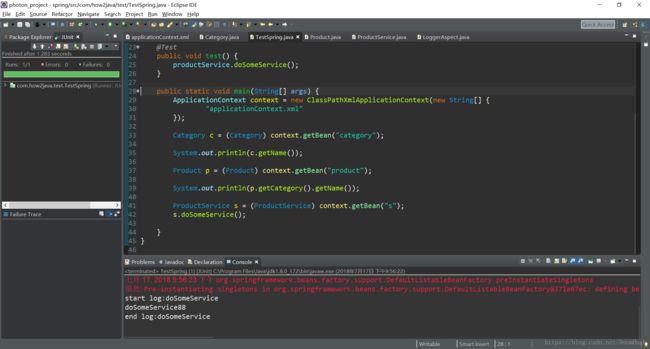spring注入、切面和测试
how2j这个网站对spring的解释非常好,摘录一些内容
1. 注入
首先applicationContext.xml是spring的核心配置文件,它写明了项目里面有哪些类是需要注入的。在这里,是把包com下面的所有类都扫描了,发现有注解的就注入。
<beans xmlns="http://www.springframework.org/schema/beans"
xmlns:xsi="http://www.w3.org/2001/XMLSchema-instance"
xmlns:aop="http://www.springframework.org/schema/aop"
xmlns:tx="http://www.springframework.org/schema/tx"
xmlns:context="http://www.springframework.org/schema/context"
xsi:schemaLocation="
http://www.springframework.org/schema/beans
http://www.springframework.org/schema/beans/spring-beans-3.0.xsd
http://www.springframework.org/schema/aop
http://www.springframework.org/schema/aop/spring-aop-3.0.xsd
http://www.springframework.org/schema/tx
http://www.springframework.org/schema/tx/spring-tx-3.0.xsd
http://www.springframework.org/schema/context
http://www.springframework.org/schema/context/spring-context-3.0.xsd">
<context:component-scan base-package="com.*"/>
beans>当然,也可以分别把每一个需要注入的类写进来:
name="c" class="com.how2java.pojo.Category">
<property name="name" value="category 1" />
name="p" class="com.how2java.pojo.Product">
<property name="name" value="product1" />
<property name="category" ref="c" />
其实这个文件的命名怎么样都行,最主要的是需要一个东西带获取它:
ApplicationContext context = new ClassPathXmlApplicationContext(new String[] {
"applicationContext.xml"
});ApplicationContext 有以下五点作用:
- Bean工厂方法,用于访问应用程序组件
- 有加载文件资源的功能
- 有发布监听器的功能
- 有处理消息和国际化的功能
- 有继承的功能,子上下文可以覆盖父上下文的配置。这意味着一个简单的父上下文可以引申出来多个子上下文,适用于项目中的各个servlet里面。
注:applicationContext.xml这个文件还有很多不明白的地方,比如开头的beans里面分别代表了什么。
在教程里面,在注解旁边写了这个bean的名字,引用的时候就写这个:
@Component("p")
public class Product {
Product p = (Product) context.getBean("p");但是如果不自定义bean的名字,那么这个bean的默认名字是该类的首字母小写,比如在这里,就是product
2. AOP
AOP 即 Aspect Oriented Program 面向切面编程
首先,在面向切面编程的思想里面,把功能分为核心业务功能,和周边功能。 所谓的核心业务,比如登陆,增加数据,删除数据都叫核心业务
所谓的周边功能,比如性能统计,日志,事务管理等等周边功能在Spring的面向切面编程AOP思想里,即被定义为切面
在面向切面编程AOP的思想里面,核心业务功能和切面功能分别独立进行开发 然后把切面功能和核心业务功能 “编织” 在一起,这就叫AOP
<aop:config>
<aop:pointcut id="loggerCutpoint"
expression=
"execution(* com.how2java.service.ProductService.*(..)) "/>
<aop:aspect id="logAspect" ref="loggerAspect">
<aop:around pointcut-ref="loggerCutpoint" method="log"/>
aop:aspect>
aop:config>execution(* com.how2java.service.ProductService.*(..))
这表示对满足如下条件的方法调用,进行切面操作:
*返回任意类型 com.how2java.service.ProductService.* 包名以 com.how2java.service.ProductService 开头的类的任意方法 (..) 参数是任意数量和类型
注解的方式:
<aop:aspectj-autoproxy/> package com.how2java.aspect;
import org.aspectj.lang.ProceedingJoinPoint;
import org.aspectj.lang.annotation.Around;
import org.aspectj.lang.annotation.Aspect;
import org.springframework.stereotype.Component;
@Aspect
@Component
public class LoggerAspect {
@Around(value = "execution(* com.how2java.service.ProductService.*(..))")
public Object log(ProceedingJoinPoint joinPoint) throws Throwable {
System.out.println("start log:" + joinPoint.getSignature().getName());
Object object = joinPoint.proceed();
System.out.println("end log:" + joinPoint.getSignature().getName());
return object;
}
}3. 测试
package com.how2java.test;
import org.junit.Test;
import org.junit.runner.RunWith;
import org.springframework.beans.factory.annotation.Autowired;
import org.springframework.test.context.ContextConfiguration;
import org.springframework.test.context.junit4.SpringJUnit4ClassRunner;
import com.how2java.pojo.Category;
@RunWith(SpringJUnit4ClassRunner.class)
@ContextConfiguration("classpath:applicationContext.xml")
public class TestSpring {
@Autowired
Category c;
@Test
public void test(){
System.out.println(c.getName());
}
}运行这个代码需要右键运行里面选择JUnitt test,快捷键 shift+alt+x, t。以前一直知道这个单元测试,今天才是第一次使用,觉得挺有意思的。这样是不是意思就是不依赖别的方法也能运行呢?回头要试试。附一张运行成功的图片:
